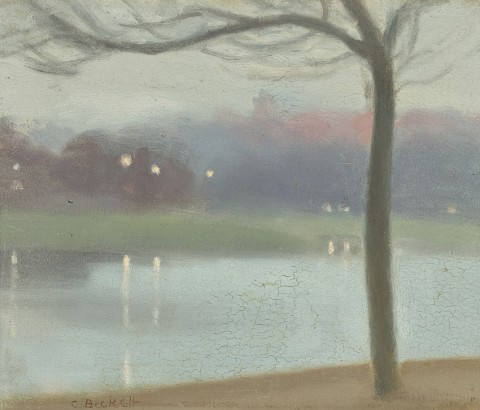VIEW ACROSS THE YARRA TOWARDS GOVERNMENT HOUSE, c.1931
CLARICE BECKETT
oil on board
25.5 x 35.5 cm
signed lower left: C. Beckett
framer's label attached verso: John Thallon, Melbourne
Private collection
Leonard Joel, Melbourne, 31 March 1982, lot 840 (as ‘Late Evening on the Yarra’)
Private collection, Melbourne
Across the Yarra, c.1931, oil on cardboard, 32.5 x 46.0 cm, in the collection of the National Gallery of Victoria, Melbourne
We are grateful to Rosalind Hollinrake for her assistance with this catalogue entry.
Clarice Beckett’s View across the Yarra to Government House, c.1931, joins other comparable pieces by the artist that reflect her ongoing fascination with the ebb and flow of life in Melbourne by the Yarra River. The exact position of this painting is easy to identity even now, clearly being captured by Beckett from near the Morrell Bridge, known then as the Anderson Street Bridge. What is even more remarkable is that the young elm tree in the foreground still stands, gnarled and majestic. Government House has towered above the Royal Botanic Gardens since its completion in 1876, but at the time of this painting, the Gardens’ boundary roads such as Alexandra Avenue were already populated by numerous cars, the lights of which can be seen dotted along the shore. Indeed, given the crepuscular light, Beckett was probably painting this work during the evening peak hour, yet such noise, movement and disruption is totally absent from this quiet meditation.
Clarice Beckett had an abiding interest in Theosophy and aspects of its philosophy permeate her paintings, such as the movement’s pursuit of the spiritual essence of the everyday. Tracey Lock, curator of the recent exhibition, Clarice Beckett: the present moment at the Art Gallery of South Australia, has further noted, ‘the technique of shrouding form [akin to Beckett’s ‘mist’] was favoured by the anthroposophist [and Theosophist] Rudolph Steiner, who suggested that luminous radiating fields of colour applied in thinned pigments could bring people to apprehend the hidden and experience a cosmic state of being.’1 Additionally, in the early decades of the twentieth century, the Pictorialist photography movement had a strong presence in Australian art with its emphasis on tonality and composition rather than simple documentation; and leading proponents included Melbournians such as Ruth Hollick, Mina Moore and John Kauffman. Likewise, John Shirlow used aquatint etching to similar ends in Melbourne at night across the Yarra, c.1910 – 20, which presents a view identical to Beckett’s View across the Yarra, c.1931, which achieved a new auction record for the artist at Deutscher and Hackett in April 2021. Max Meldrum’s influential theory of tonalism, also formulated during these years, created comparable results; however, critics derided the ‘fuzziness’ of such images. Beckett too suffered from associated negative commentary, however her art, soundly based in four years of training at the National Gallery School and one year’s study with Meldrum, fuses and transcends her influences to create paintings that are distinctly her own.
In 1931, Beckett and sixty-seven other artists were included in the First Contemporary All-Australian Art Exhibition, at the International Art Centre of the Roerich Museum, New York; and she was one of only seven artists singled out for positive comment by the critic for the New York Times.2 Poetic, mysterious and distinctly modernist, Beckett’s paintings operate as still moments in an increasingly frenetic world. In describing the effect of her individual vision, the curator Bruce James wrote that ‘her paintings are little evocations that build like musical phrases towards a greater and more compelling whole. That’s why groups of Becketts can be so thunderous.’3
1. Rudolph Steiner cited in Lock, T., Clarice Beckett: The present moment, Art Gallery of South Australia, Adelaide, 2021, p. 37
2. Jewell, E. A., ‘Australian Art Shown Here’, New York Times, 8 February 1931, section II, p. 6, column 4
3. James, B., ‘Universal vision in dull suburbia’, The Age, Melbourne, 22 March 1995, p. 23
ANDREW GAYNOR
